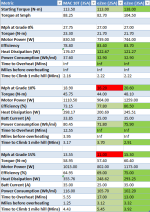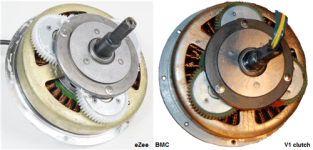iluvmylife
1 mW
- Joined
- May 30, 2014
- Messages
- 15
While I've narrowed down my choices, I'm having a hard time deciding between the Mac 10T and the eZee V2 250rpm (both geared hub motors). I have a Trek Marlin 6, 700cx2.00" wheels and 48V 15Ah Li-Ion battery from Calibikes. My requirements are as follows:
- I need the torque to climb about 13-15% grade hills in Seattle (up to 0.7 miles long). I have about 3 such hills on my 8 mile commute. I don't need to climb at high speeds (say, 10mph on hills is OK), but I should be able to start climbing from a dead stop (traffic sign)
- I'm happy with around 25-28 mph top speed on flatlands.
- I am happy to pedal assist to a certain extent. I don't want to exert myself on the hills though (don't want to reach work all sweaty)
I live in Seattle, so ordering the eZee from ebikes.ca in Vancouver is more convenient (warranty, spare parts, etc.). However, the eZee V2 kit only comes with a 25A controller (don't know if its safe to run with at a higher amp controller). On the other hand, the Mac 10T can be run at 30A, hence higher torque, but has to ship all the way from China. Any thoughts on the low speed torque of the two?
Any thoughts on which of the two motors fits the bill better would be much appreciated!
- I need the torque to climb about 13-15% grade hills in Seattle (up to 0.7 miles long). I have about 3 such hills on my 8 mile commute. I don't need to climb at high speeds (say, 10mph on hills is OK), but I should be able to start climbing from a dead stop (traffic sign)
- I'm happy with around 25-28 mph top speed on flatlands.
- I am happy to pedal assist to a certain extent. I don't want to exert myself on the hills though (don't want to reach work all sweaty)
I live in Seattle, so ordering the eZee from ebikes.ca in Vancouver is more convenient (warranty, spare parts, etc.). However, the eZee V2 kit only comes with a 25A controller (don't know if its safe to run with at a higher amp controller). On the other hand, the Mac 10T can be run at 30A, hence higher torque, but has to ship all the way from China. Any thoughts on the low speed torque of the two?
Any thoughts on which of the two motors fits the bill better would be much appreciated!



